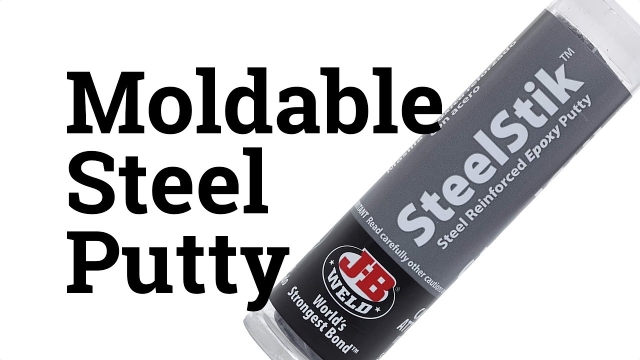Metal putty has long been favored by professionals and DIY enthusiasts alike as a powerful tool for repairing and restoring various metal surfaces. From minor dents and scratches to larger scale damage, metal putty filler has the ability to work miracles, providing a quick and effective solution for transforming worn-out or damaged metal objects into magnificent creations once more.
One of the key advantages of metal putty is its versatility. Whether you need to fill in gaps, rebuild missing sections, or simply smoothen out imperfections, this multifaceted substance rises to the occasion. Capable of adhering to almost any metal surface, metal putty is a reliable choice for a wide range of applications, including automotive repairs, household fix-ups, and even artistic endeavors.
What sets metal putty filler apart from traditional methods of metal repair is its ease of use. With its putty-like consistency, it can be easily molded and shaped to fit the specific requirements of your project. Whether you’re a seasoned professional or a DIY enthusiast tackling your first metal restoration task, you’ll appreciate the user-friendly nature of this remarkable substance.
Furthermore, metal putty filler offers long-lasting durability, ensuring that your repairs stand the test of time. Once applied and cured, it forms a strong bond with the metal surface, capable of withstanding even the harshest conditions. This means that your beautifully restored metal objects can go on to endure years of use, proudly displaying their renewed magnificence for all to see.
In the following sections, we will explore the various types of metal putty filler available, their specific applications, and offer helpful tips and tricks for achieving the best results. By embracing the power of metal putty, you’ll unleash a world of possibilities for giving your metal objects a truly magnificent makeover. So, let’s dive in and discover the wonders of metal putty filler together!
Benefits of Metal Putty Filler
Metal putty filler offers a wide range of benefits for various applications in different industries. From repairing metal surfaces to providing a strong bond, this versatile product is a must-have for any metalwork project. Let’s explore some of its key advantages below:
-
Seamless Repair: One of the major benefits of metal putty filler is its ability to seamlessly repair damaged metal surfaces. Whether it’s a dent, scratch, or hole, this filler can be easily applied to restore the original shape and smoothness of the metal. Its malleability and adhesive properties ensure a strong bond, creating a seamless finish that is virtually indistinguishable from the original metal surface.
- metal putty epoxy
Versatility: Metal putty filler is compatible with a wide range of metals, including steel, aluminum, brass, and more. This makes it suitable for various applications across different industries such as automotive, construction, and manufacturing. Whether you need to repair a car body, patch up a metal pipe, or restore a metal sculpture, this filler can do it all.
-
Durability: Metal putty filler provides exceptional durability, making it capable of withstanding harsh environments and heavy usage. Once applied and properly cured, it forms a strong and resilient bond that resists cracking, peeling, and corrosion. This ensures that repaired metal surfaces maintain their integrity and continue to perform effectively over time.
In conclusion, the benefits of metal putty filler are vast and make it an essential tool for anyone working with metal. Its seamless repair capabilities, versatility across different metals, and long-lasting durability make it a reliable option for a wide range of applications. Whether you’re a professional metalworker or a DIY enthusiast, metal putty filler is a valuable addition to your toolkit.
Application Techniques for Metal Putty
In order to achieve the best results when working with metal putty, it is important to follow the correct application techniques. When applying metal putty filler, there are a few key steps to keep in mind for a successful and long-lasting metal makeover.
-
Surface Preparation:
Before applying the metal putty filler, it is crucial to prepare the surface properly. Start by cleaning the metal surface thoroughly, ensuring it is free from any dirt, grease, or rust. Use a degreaser or solvent to remove any contaminants, and then dry the surface completely. This will ensure proper adhesion of the metal putty filler. -
Mixing the Metal Putty:
Next, it is important to mix the metal putty filler according to the manufacturer’s instructions. Typically, metal putties come in two parts – a resin and a hardener. Measure out the correct ratio of resin and hardener, and thoroughly mix them together until you achieve a uniform color. Be sure to follow the recommended mixing time to ensure proper curing and performance of the metal putty. -
Applying the Metal Putty:
Once the metal putty filler is mixed, it is time to apply it to the prepared surface. Use a suitable applicator, such as a putty knife or a plastic spatula, to spread an even layer of the metal putty over the damaged or uneven areas. Apply the putty in thin layers, gradually building it up as needed. Smooth out the surface as much as possible for a seamless finish.
Remember, it is important to work quickly but accurately when applying metal putty filler, as it tends to cure relatively fast. Avoid applying too much putty at once, as this can result in sagging or unevenness. If necessary, you can sand the cured putty after it has fully hardened to achieve a smoother and more refined surface.
By following these application techniques for metal putty, you can unleash the power of this magnificent metal filler, transforming damaged or unattractive surfaces into a flawless and durable masterpiece.
Tips for Achieving a Professional Finish
-
Patience is Key: When working with metal putty and metal putty filler, it’s important to take your time to achieve a professional finish. Rushing the process can lead to a sloppy outcome. Allow ample drying and curing time as instructed by the product manufacturer. This will ensure that the putty settles and hardens properly, resulting in a smooth and even surface.
-
Smooth Operator: To achieve a professional finish, it is essential to sand the surface after applying the metal putty filler. Begin with a coarse-grit sandpaper to remove any excess putty and to shape the repaired area. Gradually progress to finer grits to smoothen the surface further. Be attentive to any imperfections or unevenness, and continue sanding until you achieve a seamless blend between the repaired area and surrounding metal.
-
Prime and Paint: After achieving a smooth surface, it’s time to prime and paint the repaired area. Apply a metal primer specifically designed for use with metal putty and allow it to dry thoroughly. Once the primer is dry, choose a high-quality paint that matches the color and finish of the surrounding metal. Apply the paint evenly, using multiple thin coats for the best results. This will help ensure a professional and uniform appearance, seamlessly blending the repaired area with the rest of the metal surface.

Remember, by following these tips and taking the necessary time and care, you can achieve a professional finish when using metal putty and metal putty filler.






